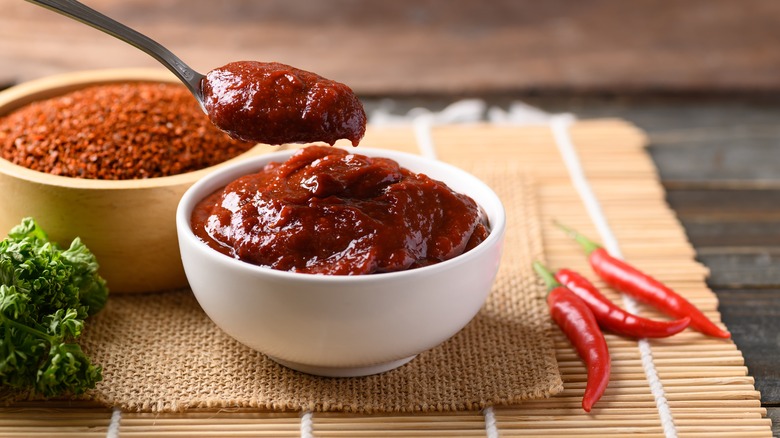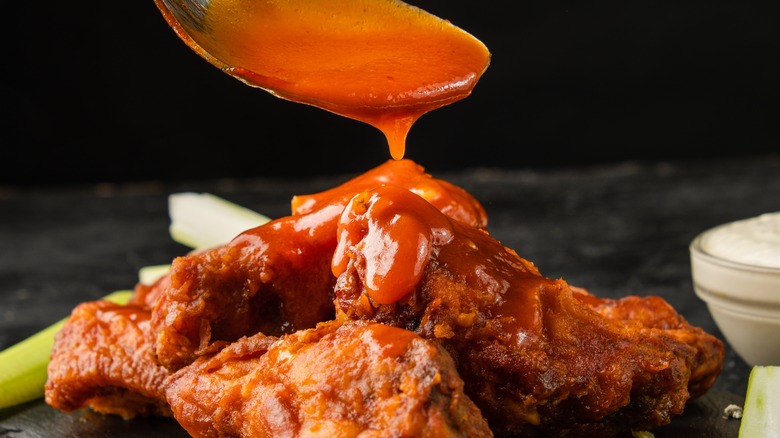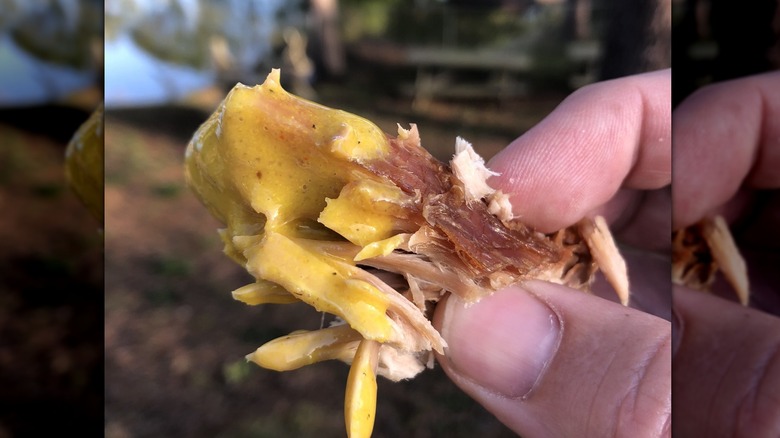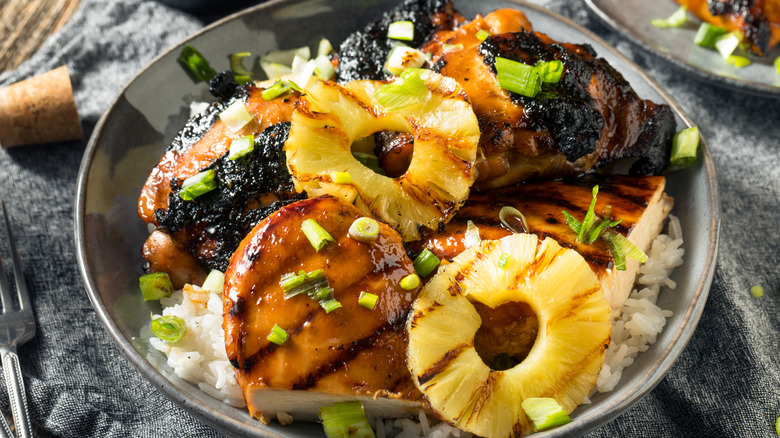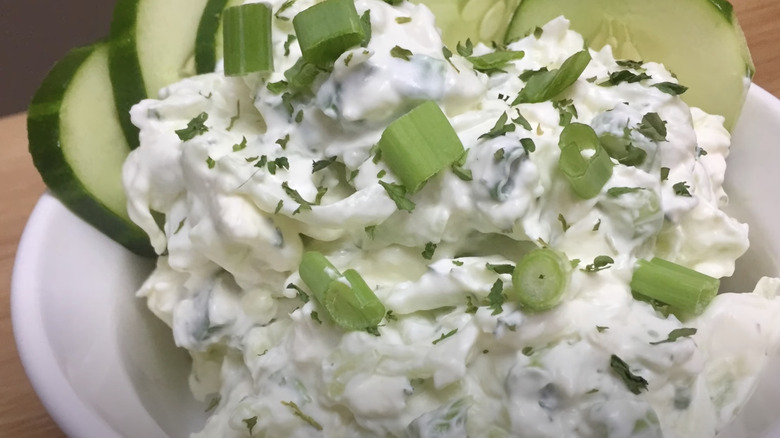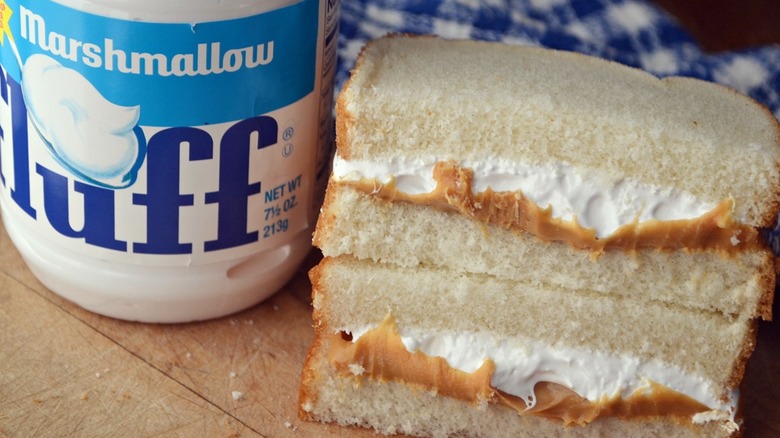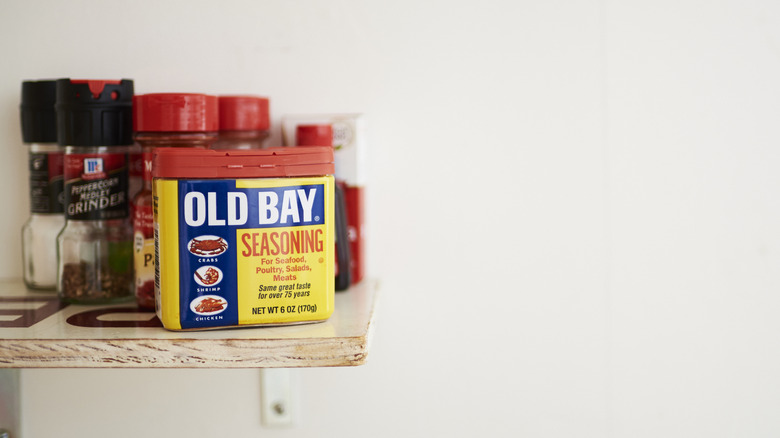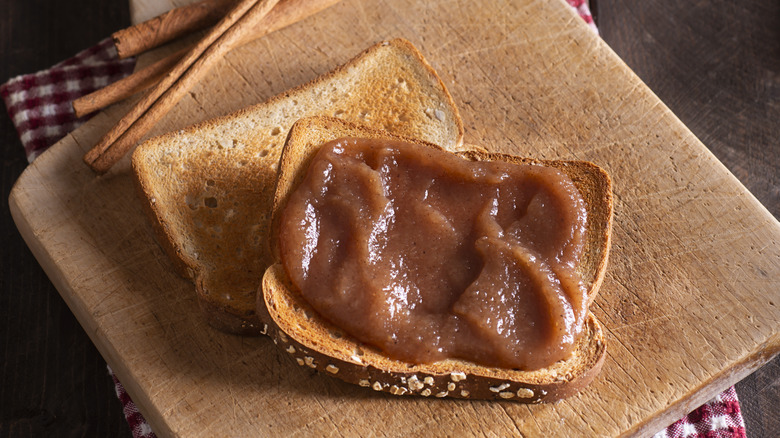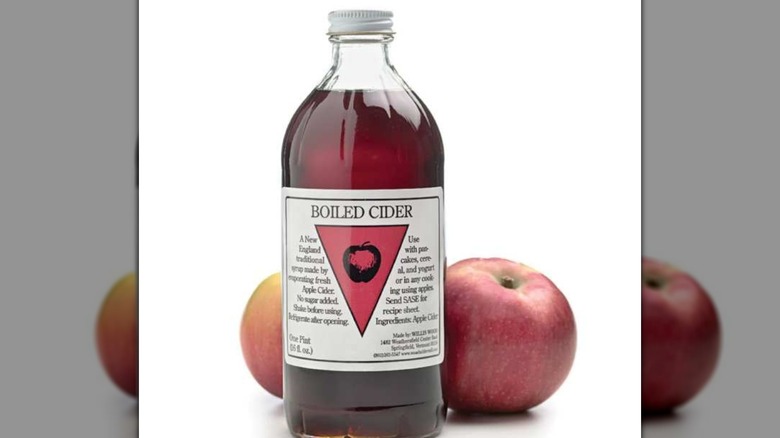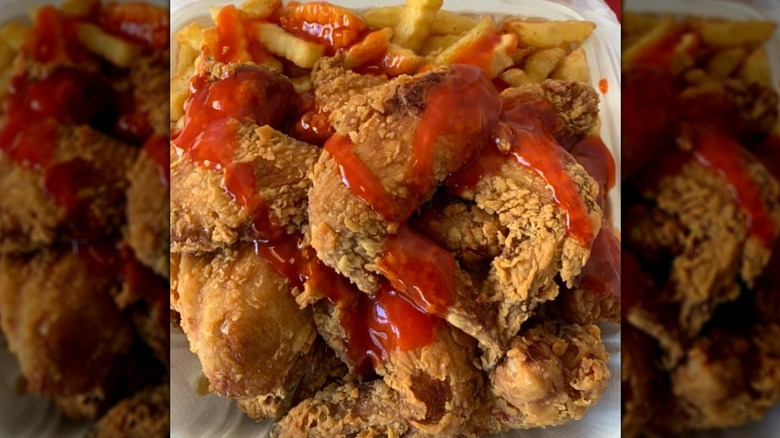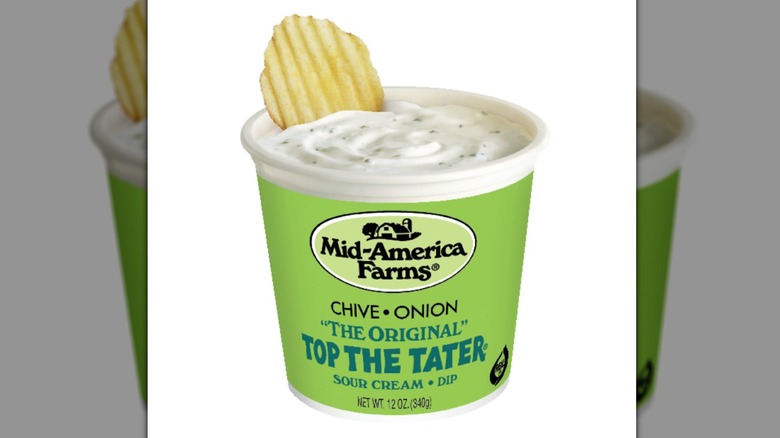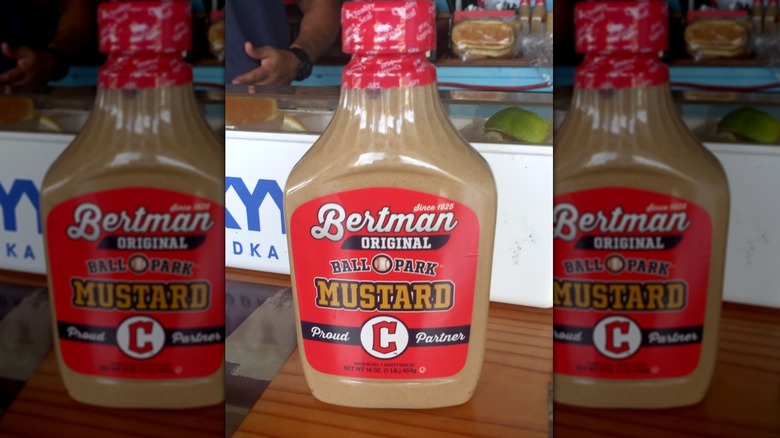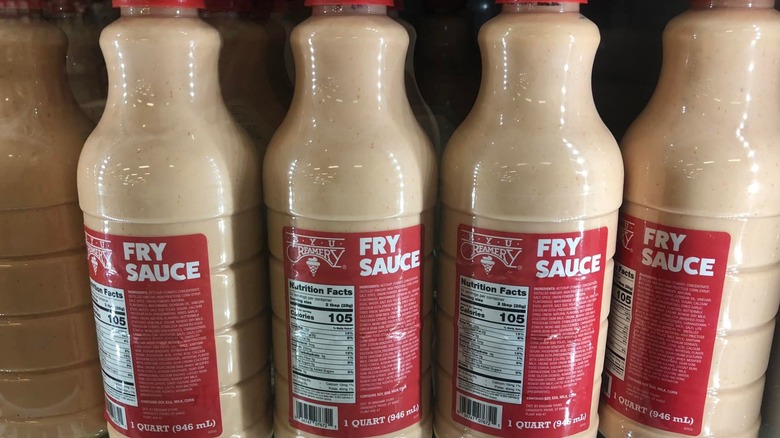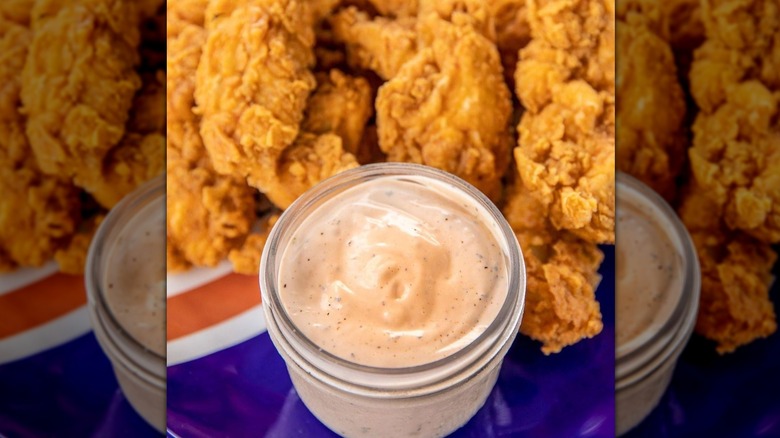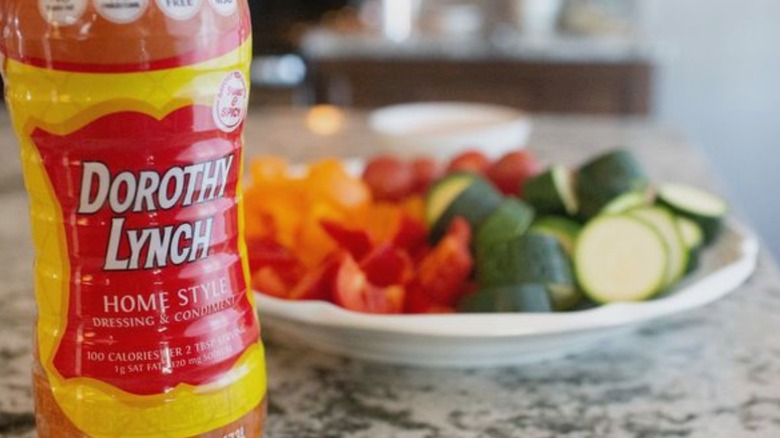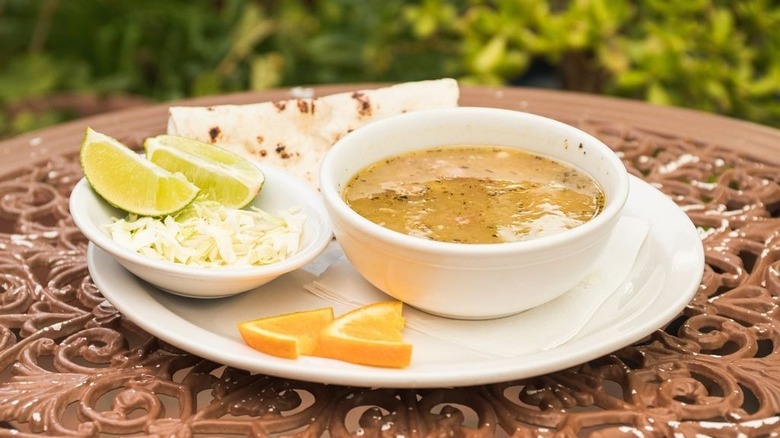America's Favorite Regional Condiments, Sauces And More
Humans have a natural appetite for finding ways of making foods more flavorful. Today, while grocery stores have dedicated aisles and kitchens have dedicated cabinets, sauces and condiments haven't always been widely available. According to My Sauces, sauce can be traced back to a 200 A.D. Roman recipe book called "De re coladora" by Marcus Gavius Apicius. The sauce they used at the time was called garum, and it consisted of sun-fermented fish intestines seasoned with spices like cumin, cardamom, coriander, and honey, along with perfume and flower petals.
Nowadays it's hard to imagine a hot dog without ketchup or a hamburger without mayo. Like the Romans, many civilizations have braved the bland so that we can drench our food in savory, sweet, and everything in between. Despite their place in the world, each inventor was led by an insatiable hunger for tastiness. Endlessly versatile, aside from familiar sauces and condiments, there are lots of unique flavors in cities across America that you may have never had the pleasure of experiencing. From the South's penchant for barbecues to the Midwest's love for vinegary sauces, you'll find no shortage of styles to try. To help you on your tour of "Sauceville," we've put together a list of American sauces and condiments popular in different regions.
Buffalo Sauce - New York
This iconic bar staple and Sunday football go-to finds roots in the city it's named after, Buffalo, New York. Long after it became a classic wing sauce, it was believed to have been invented by Frank and Terassa Bellisimo, owners of the local establishment "Anchor Bar." In 1972, articles from the Associated Press and The New Yorker helped to establish them as the creators of buffalo wings.
Ironically, The New Yorker also interviewed another man named John Young, who contested the couple's claim. Only in the past twenty or so years did food historians discover that Young was telling the truth. Young is the owner of Wings and Things, which was opened in 1962 and was located only a mile away from Anchor Bar. In the interview, he revealed that Mr. Bellisimo used to come by and eat his wings all the time. Buffalo wing sauce is a fairly simple recipe made with hot sauce, apple cider vinegar, Worcestershire sauce, and unsalted butter, but it's grown to become an American staple.
White Sauce - Alabama
Although barbecue sauce is most often tomato-based, Alabama puts its own special spin on the classic condiment. Called Alabama "white sauce," it's made using mayonnaise and vinegar, along with Dijon mustard, Worcestershire sauce, garlic, onion powder, cayenne, black pepper, and a pinch of salt. Locally people enjoy their barbecue favorites lathered on or dipped.
Tangy and savory, Alabama white sauce is a super versatile condiment that can top fried foods, sandwiches, and potato salad and can even be used as a salad dressing. The best part about this Alabaman condiment is that it only takes five minutes to prepare.
Yellow Mustard BBQ Sauce - South Carolina
Odds are you're no stranger to yellow mustard. Well, in South Carolina, yellow mustard is transformed into a tangy-flavored barbecue sauce. It's given a touch of sweetness with brown sugar or honey and a punch of zest with apple cider vinegar and black pepper. A local favorite, when South Carolina barbecue sauce is slathered atop chicken or pork, it becomes a succulent affair.
To give you an example of how deep the passion for barbecue runs there, according to The South Carolina Barbecue Association, it's "where the art of barbecue was invented and where it is still practiced in both its purest tradition and its most diverse styles." Don't know about you, but that sure sounds like they know their barbecue!
Huli Huli Sauce - Hawaii
From large luau's to roadside stands, barbecue plays a pivotal role in Hawaii. As a melting pot of Asian cultures, the food is a fusion of flavors, making its barbecue uniquely regional. Whereas luaus are popularly known for having elaborate platters, another common source for delicious barbecue is the island's countless huli huli carts.
Emitting a tantalizing and distinctive smokey aroma, huli huli is a special BBQ sauce made with Polynesian-inspired ingredients like pineapple, ginger, garlic, and soy sauce. It's most often served with chicken that's marinated for at least eight hours to ensure maximum smokey and savory satisfaction. The word huli means "turn," which refers to the cooking method of turning it on the grill every five minutes to prevent burning.
Mild Sauce - Chicago
As a major contributor to classic American cuisine, when you visit Chicago, there are certain foods that you absolutely must try. While an authentic deep-dish pizza and a Chicago-style dog are obvious ones, a lesser-known local fav is simply called mild sauce. Mild sauce is easily one of the most underrated Chicago foods. It's one of those condiments that tastes better the more you add it on, and boy, do Chicagoans add it on.
Mild sauce is most commonly made with a mixture of hot sauce, barbecue sauce, and ketchup. It has a spicy kick that'll help stave off the inevitable gusts of wind. There's nothing more Chi-Town than a greasy bag of freshly made fries submerged in a healthy helping of mild sauce. Just make sure you ask for extra napkins.
Benedictine - Kentucky
The Bluegrass State is no stranger to full-bodied flavor. Its bourbon will put some fire in your belly, and its bold barbecue will melt on your tongue. Beyond barrel-aged booze and fried chicken, Kentucky has a wide range of regional offerings worth experiencing. One unique dip is called benedictine — it's a mayonnaise-based dip that's mixed with a blend of cream cheese and sour cream.
Not your ordinary sour cream and onion, Benedictine is a combo of minced cucumbers and yellow onion, followed by salt, black pepper, cayenne, and dill. It's a quick and creamy dip for vegetables, meats, cheeses, and of course, salted potato chips. Keep it in your culinary queue and save it for the next barbecue.
Creole Mustard - Lousiana
The South is notoriously known for liking their food with a little kick. New Orleans in particular is a foodie hot-spot, and there, Creole is one of two major cuisines. Often confused with its spicier cousin Cajun, Creole-flavor is a more herbaceous blend of paprika, cayenne, thyme, garlic, onion, smoked paprika, salt, pepper, and basil.
In Lousiana, it's added to mustard and becomes what locals refer to as Creole mustard. Infused with the taste of the bayou, it goes great with vegetable platters, and is often used on po'boy sandwiches and in New Orleans-style remoulade sauces. If you have the itch to try out something new in the kitchen, we recommend this Creole mustard-braised chicken thigh recipe.
Marshmallow Fluff - New England
Easily one of the most unique condiments that has a regional legendary status is Marshmallow Fluff. Beloved by New Englanders, the sugary condiment is still produced in Lynn, Massachusetts, where it was first created in the 1920s. Marshmallow Fluff is made of only four ingredients — corn syrup, sugar, powdered egg whites, and vanillin, an artificial vanilla flavor.
It has a stretchy, gooey texture that's spreadably delicious. Along with the iconic fluffernutter sandwich (composed of marshmallow fluff and peanut butter), it also goes excellent with rice crispy treats, cake frosting and filling, topping for cocoa or ice cream, and can be used to make a mean meringue too.
Old Bay Seasoning - Maryland
Dubbed "The Spice of Baltimore" by the Baltimore Jewish Times, Old Bay Seasoning is a nationally known brand that was invented over 80 years ago by a Jewish immigrant named Gustav Brunn. After escaping from a concentration camp, he settled in America and started the Baltimore Spice Company, where he accidentally invented Old Bay seasoning in an attempt to keep other manufacturers from stealing his recipe.
At the time, U.S. law mandated that ingredients must be declared, so Brunn included trace amounts of cinnamon, nutmeg, cloves, and other spices, unintentionally creating a completely new crab seasoning. With a total of 18 ingredients, the special blend that makes Old Bay so popular is still kept secret.
Michigan Sauce - Michigan
Hot dogs are one of the most versatile comfort foods in America. Different regions add their own flare to frankfurters, and the different toppings offer a taste of local styles. The Midwest is notable for its love of hot dogs. In Michigan, the dogs come covered in a thick and savory meat sauce called "Michigan Sauce."
Depending on where you get it, the flavor of the sauce can vary from tomato-tasting to meaty with a kick. It's the salty and zesty sauce that makes Michigan hot dogs unique. There's also a particular type of frank used. The Great Lake State prefers the "red skin" hot dog variety.
Dutch Apple Butter - Pennsylvania
Pennsylvania is the birthplace of a long list of classic American foods. From cheese steak to banana split, there's no wonder it's home to some crave-worthy sauces and condiments too. One creamy classic locals love is Dutch apple butter. The name refers to its buttery consistency, it doesn't actually contain dairy.
Apple butter was carried over from Germany by descendants who became local to the area, the Pennsylvania Dutch. They refer to apple butter as lattwaerrick. It was invented by monks as a way to preserve fruit and is made by cooking chopped and peeled apples with honey, brown sugar, and apple cider in a large pot. After being initially cooked, it's then puréed and cooked once more with ground cinnamon, ginger, and nutmeg until it has a concentrated apple sauce consistency.
Boiled Cider - Vermont
When you think of Vermont, maple syrup probably comes to mind. As the highest producer of maple syrup in the U.S, don't be surprised if you've never heard of Vermont's other drizzle-worthy condiment: Boiled cider (or apple molasses). Boiled cider has a syrupy consistency that's rich and chunky. To make it, fresh cider is boiled until it reduces down to a thick, goo-like consistency.
Traditionally, boiled cider is used as a salad dressing, glaze for meats, mincemeat, vegetable dishes, and its namesake "boiled cider pie." Although easy to make, there is a caveat, you'll need one gallon of preservative-free apple cider and five hours of free time.
Mambo/Mumbo Sauce - Washington D.C.
Not to be confused with the Cuban ballroom dance, mambo (or mumbo) is a sweet and tangy chicken wing sauce that comes from Washington D.C., by way of Chicago. Deliciously versatile, locals also love to pair it with Chinese food, use it as a substitute for ketchup and barbecue sauce, and sometimes even duck sauce.
Mumbo sauce is basically ketchup blended with sugar and tangy fruit juices like pineapple and lemon. Zesty vinegar, honey, soy sauce, and piquant ginger, and cayenne pepper are also incorporated. While you're unlikely to find this in your grocery stores, locally, there are quite a few brands that make mumbo sauce. Don't fret if you aren't a resident of D.C., though, it's a pretty easy sauce to make from scratch too.
Top The Tater - Midwest
You must admit, the Midwest knows a thing or two about making great sauces and condiments. This next classic flavor booster is not only delicious, it has a fun name, too: Top The Tater. As the name suggests, Top The Tater is for tater-topping, amongst other tasty pairings. It's made with fresh sour cream mixed with chives, onions, and a unique seasoning blend.
On the surface, it may seem like your everyday sour cream and onion dip, but this special condiment has had a diehard Midwestern following since the 1960s. Aside from potato chips, Top The Tater goes great with pretzels, veggies, burgers, or whatever your cravings demand.
Ball Park Mustard - Ohio
Mustard is one of those condiments that nearly every region has put its own spin on. From delicatessen to Dijon, there's a wide selection to choose from. Ohio loves brown mustard and, in particular, two local staples: Bertman Original, enjoyed since 1925, and Stadium Mustard, which claims to have been selling its recipe since the 1800s.
Brown mustard is a stronger flavored variety and packs more punch than yellow. A couple of fun facts, Bertman Original is the official mustard of the Cleveland Guardians, and while Stadium Mustard doesn't hold that hometown honor, it's still distributed at 150 stadiums in the U.S. If you prefer some sweetness, Bertman adds a bit of sugar, while Stadium Mustard tends to be spicier.
Fry Sauce - Utah
The purpose of this next savory condiment is clear: to douse your fries with deliciousness. Fry sauce has been around for some time. It's a heavenly pairing of tomato ketchup, mayo, garlic, and a blend of seasoning that originates in Utah, and was created during the mid-20th century by Don Carlos, founder of a local fast-food chain called Artic Circle.
In order to save time, Carlos began combining ketchup and mayo together beforehand. He initially called it "pink sauce." As it grew in popularity, customers began dipping their fries in it, which eventually inspired the name we call it today. Fry sauce doesn't just taste great with taters, feel free to pour some on any succulent piece of meat sandwiched between slices of bread.
Comeback Sauce - Mississippi
You know a sauce is incredible when it's named after a demand. Comeback sauce is a Mississippi-bred condiment that's grown to become a Southern staple. Comeback sauce traditionally consists of ketchup, mayonnaise, and chili sauce as the base. Pungent components like yellow onion, Worcestershire, garlic, paprika, black pepper, and lemon juice add an aromatic oomph.
While there are variations, quality comeback sauce is always made using fresh ingredients. It's creamy and full-flavored, has a peppery zing, and is ideal for dipping, dressing fresh salad, drizzling atop roasted vegetables, or spreading on a meaty burger. It's pretty much an all-purpose deliverer of deliciousness. We definitely recommend preparing a batch of this comeback sauce and storing it for this week's recipes.
Dorothy Lynch Dressing - Nebraska
There are certainly a lot of interesting names for sauces out there, but self-named ones aren't often among them. Dorothy Lynch dressing is a home-style, tomato-based sauce that hails from Nebraska. Made using a secret blend of spices, it was named after a woman who owned a restaurant with her husband in St. Paul, Nebraska, during the 1940s.
The orange-colored dressing would grow to become a local sensation and a notable part of local cuisine. It tastes sweet with a kick and has a thick and creamy consistency that pairs perfectly with everything from sandwiches to guacamole.
Hot Wiener Sauce - Rhode Island
While Rhode Island is rarely celebrated for its culinary scene, it boasts excellent eats just like any other state. There, locals love a good hot wiener; in fact, the place is littered with "wienie joints," and many have loyal followings thanks to the regional hot wiener sauce. The sauce that makes a regular dog into a hot wiener is traditionally made with mustard, savory meat sauce, diced onion, and celery salt, all served on a steamed bun.
To make it easy, just ask for it to be made "all the way," which is how residents order an original hot wiener. Although one might mistake it for a regular chili dog, Rhode Island hot wieners vary in flavor from location to location. Some spots have operated for more than 70 years, and safeguarding original recipes is key to retaining its iconic taste.
Hatch Green Chile Sauce - New Mexico
Grassy, fresh-tasting, and smokey-flavored, hatch green chile sauce is a New Mexican culinary treasure. The chile itself originates from the state's Hatch Valley, located to the south, which is why it's featured prominently in local cuisine. Thanks to a sun-rich environment, most of the 150 million pounds that the state produces are solar-roasted.
It's a cleaner process that roasts without impacting flavor. Hatch chiles can range from mild to hot depending on the variety, and the sauce is an all-around great condiment for dippers, spreaders, dousers, and drizzlers. You should be able to find it fairly easily online, or you can make it from scratch in under an hour.
